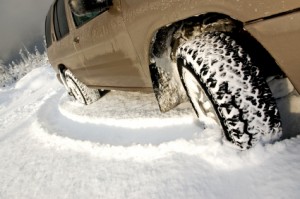
When snow starts to fall, drivers everywhere ease off the accelerator. Slippery conditions resulting from ice, slush and snow on the road can be challenging to navigate, especially to the inexperienced driver. To gain back some control, many people mount snow tires on their cars. But is it necessary to have two sets that change with the seasons?
How snow tires work. As their name suggests, snow tires are designed to give the driver maximum traction and control in icy or snowy driving conditions. This is achieved in several ways:
- Snow tires use special rubber compounds that are designed to increase grip at low temperatures. The rubber is soft and flexible, which allows for better traction and control.
- The tread is cut into shapes and wide grooves that increase the tire’s ability to expel snow and ‘grab’ the road.
- Hair-thin cuts in the tire, called ‘sipes,’ cross the tire at various angles. This creates edges in different sections of the tire that help grip the road.
The result of these modifications is a tire that performs well in snow, but is softer and less stable than the typical all-season tire. If used in the summer, the hard road and hot asphalt would wear a snow tire at a greater rate than an all-season tire.
How all-season tires work. All-season tires are expected to perform no matter what time of year it is. Since it’s difficult to design a tire that gives optimum performance across a variety of road conditions, they do not perform as well as snow tires on ice-covered streets. According to discounttire.com, snow tires offer 25-50 percent better traction in winter than all-season tires. All-season tires work well in the fall, spring and summer months due to stiffer rubber and treads designed for hard asphalt.
Do you need both? If you live somewhere that gets a lot of snow, it’s a good idea to own both sets of tires. Snow tires can greatly improve vehicle handling and decrease driver frustration during the winter months. Drivers should also consider the cost of an additional set of tires when making a decision. The approximate cost of a set of tires is $400, but can vary based on the type of vehicle you own and the brand of tire you buy. Having an extra set of rims on which to mount the tires is an additional expense, at about $150 per rim, but one that will make your seasonal tire change much easier. In total, you should be prepared to spend around $400 for tires alone or $1,000 for snow tires and rims.
Tires are just one aspect of staying protected on the road. Make sure your vehicle is also covered with an affordable auto insurance policy. To avoid paying too much, get quotes from several insurance companies and get the coverage you need this winter.
Dale Cooper is a content specialist at Rosetta, a full-service interactive marking agency. He has worked in the SEO and online marketing space for two years, and holds a B.A. in English.
Editors Note: We welcome submissions of appropriate articles for our readers. Inclusion of a guest post on this blog does not imply endorsement of the contents of linked pages, nor of the organization supplying the article. We do however support and appreciate the value of the information contained in the article for the benefit of our readers.
If you’re struggling to pay off debt, ACCC can help. Schedule a free credit counseling session with us today.





